.
Administrative Region : North Aegean
Regional unit : Limnos


Plaka (Greek: Πλάκα), accented form: Pláka is a Greek village 35 km ENE of Myrina in the municipality of Moudros, Greece. Its 2001 population was 365 people. It is located in the northeast of the island of Lemnos. It is the only place on the whole island that the center lies north of the 40th parallel, parts of it are below the parallel. The island of Imbros in Turkey is just 20 km northeast.
Population
Year Population
1928 518
1958 578
1981 384
1991 365
2001 365
Name
Plaka receives its name from a nearby cape of the northeasternmost part of Lemnos with grey white different tiles. The cape was mentioned by older travellers with different names: Palaqa burnu (Piri Reis 1521), Blava (Belon 1548, Dapper 1688, Choiseul-Gouffier 1788, Lacroix 1858) and Plaka (Conze 1858, Tozer 1859, De Launay 1894, Hauttecoeur 1903, Fredrich 1904).
It is situated somewhere in the middle of the straight line between Troy and Mount Athos. Some believe that it is the Ermaion lepas of the ancient, through which was transmitted with fire the news of the sack of Troy to Argos and Mycenae. Although the edge has an elevation of just 70 m, the cape comes deep into the sea and it is easily seen from those two areas. That is why in 1912 a 30 m high rotating lighthouse was built with a luminous range of 20 nautical miles (37 km). To the west, the light shines to the shallow waters of Plaka-Sotira and to the east is easily seen as far as the Dardanelles protecting the sailors from the Mythones shoals.
Ancient times
Axia
Between the villages of Panagia and Plaka features today a wasteland that was the medieval settlement of Axia (Αξιά) or Naxia (Νάξα), as it was mentioned in 1321 in a patriarchal paper as "Agii Anargyri is tin Nakissa". According to Argyrios Moschidis it derived its name from the ancient area of Akesa (Άκεσα), named after the verb akeomai: regain my health,recover by Philoctetes who was said to be cured there from a snake bite.
A monastery was later built at the site dedicated to "Agii Anargyri" doctors and healers. In the area coins and pottery were found and thereby was characterized as an archeological site. Angelis Michelis mentions an old pier. Further northward in Roussonia (Ρουσούνια) springs with radioactive water for bathing and mud baths are located. Nearby featured a chapel known as Ag. Charalambos. Sick persons from all of Lemnos used to made it with a donkey for coating themselved with mud. Several decades ago expatriates from the USA built a new chapel of Agios Charalambos and a block of cells for the visitors.
Kastrin
A 1355 paper under the census of the Great Lavra Monastery in Athos mentioned that there was an embattled camp settlement known as Kastrin (Καστρίν) in the area around Plaka. Probably it is the same Kastrioti Castle where in 1459 Kritovoulos from Imvros landed and kicked out the Venetians from the island.
In 1521, a Turkish sailor Piri Reis named it "Burun Hisãr", (literally the Castle of the Cape). He found it deserted the inhabitants having settled in Palaiokastro Myrina during the years of Bayezid II (1481–1512).
This embattled camp settlement was located at a tiny peninsula east of the village next to an old port. The ruins are now known as Palaiokastro or Vriokastro (Βριόκαστρο). As Vriokastro is found in the maps of Conze (1858) and Fredrich (1904). Conze found it ruined. There where many cisterns in the internal, one of these stil strong and in a wall he found an ancient writing.
Chryse
In the southern part of the Vriokastro peninsula at a distance of 800 m from the coast and east of the shoal Vina, ruins of a sunken ancient city where found, examined by professor Moutsopoulos in 1969. He spoted a block of buildings with walls up to 2 meters, monolith lintels and stone paved roads. The entire complex thinks it is a prehistoric city of Lemnos (Poliochne).
A sunken ancient city is known open to the east coast in Mythones. The ruins first known by Choiseul-Guffier in 1785 where compared with the homeric island of "Chrysi" (Chryse).
Obviously in the past there was land to the east of the Plaka peninsula, which was either united with the mainland by a narrow panhandle or was a separate island. On this stretch of land was most probably located the city of Chryse of the Homeric period - sunk in 197 B.C - and other settlements, their ruins easily seen now in the depths of the sea.
The founding of Plaka
The area around Plaka was at the beginning a place for contemporary living for the inhabitants of Agios Ypatios and Palaiopoli (Hephaestia) who had land in the area and went to farm. Since 1823 several farmers began to live there permanently and when they became a lot, they established a dorp.
In 1854 there was still no parish, as the village is not mentioned in the catalogs of the local church. Also in 1856 there was no official settlement as the village is not mentioned in the catalog of taxation for non having army obligation men of the island. Conze who visited the aeria in 1858 found only a few separated huts, therefore he did not make any remarks for a hamlet. He found though a few people who lead and guided him to Vriokastro. In the 1863 census it had 60 families and the settlement is referred as Plaka or Neochorion. In 1874 there where 70 families and 87 houses in the village, known then as "Symferoupoli" (Συμφερούπολις:town of public weal). The name was accredited to the eparch Joakim III in whom addressed the residents when they applied to run a community, when they left Agios Ipatios due to public weal reasons.
With the name Simferoupolis the village is mentioned rarely in the community papers until 1888 when eparch Ioakim died. Since that time the now known name was established. As Plaka is mentioned in the traveller's maps and writings of De Launay (1894) and Fredrich (1904).
The church
In 1896, the church of Agios Dimitrios was built by the inhabitants in a location of an older temple in which a section was inaugurated by the eparch Joakim III along with the founding of the village, so it should not be before 1860.
The chancel screen has a baroque architecture, it is an older one (late 18th century) and was transferred by a monastery in Lesbos. The bell tower is newly made.
The school
In 1870, the residents opened a school. In 1866, a school building was built by the people with the residents from Panagia and asked to become a community school, in which became in 1887. It had two class and for the rest students attended in nearby Kondopouli.
It ran in a problematic school facility, it was mentioned as a poor facility in 1904. A new section was added in 1928 and 1929. The property was bought with the council and communal aid by Nikolaos Kondaridis, a trader and president of the community and of the Egyptian Ioannis Piromaglos, and the building was made with personal work of the inhabitants.
Students and alumni included father Manolis Christodoulou (1883–86), Kon. Bouroukos (1886–1901), Antigoni Haritonos (1938–47), Stavros Samailidis (1949–54), Kostas Kontellis (1965–71) and Maria Keramidou (1966–75)
Economy - Other
From the memorization of the extremity of Lemnos, the village founded its economic support mostly on wheat and cotton production, even in manufacturing, honeycomb, fishing and sponge productions. Until 1922, its revenue came from its immigrants from the beaches of Asia Minor.
The village was self-sufficient and its residents used to have good time in every chance.
Generally, Plaka's inhabitants work and are welcoming and progressive. In 1925, a car road made it near the village but had a miserable length. Then, its inhabitants built a bridge above a stream which hindered access to the village and tried to improve the road litle by litle every year.
The modern years
The settlement was developing continuously until the 1960s. In 1928 it had 518 people, in 1961 had 578. In 1938, the school had 107 students. It became two-tier from 1929 until 1966 and was elevated to a three-tier. Later on, it began to lose roots. In 1975, the school returned to a two-tier and in 1991, it had 365 people.
Today, the village continued to be one of the most living village in the island, has an active cultural council, that keeps the old customs, though with the youth of Panagia founded a soccer club, Aetos.
It also has a Plaka-Panagia Fishing Council, the cheese factory in Kafalti and in Athens a council for immigrants abroad.
Other
The annual meeting at Agia Anna (Saint Anne). Plaka is only 12 nautical miles (20 km) from Imbros. In the 1970s and the 1990s, many Imbros descant came here to perceive the island from far. Slowly, the Imbros Council of Lemnos was founded and became an annual festival in Plaka with a revival of traditional Imbrian customs. For this, the Saint Anne Chapel was opened in 2003. It is located exactly opposite one of a corresponding location at Cape Pyrgos in Imbros which was ruined by fanatic Turks. It is notable that Saint Anne in Imbros was built by a Lemnian Ioannis Antoniadis in 1860 fulfilling one offering, as was announced by a relative recording.
People
* Komninos Piromaglou, politician, writer and historian (1899–1980), founder of EDES (ΕΔΕΣ) and member of the Parliament with EDA (ΕΔΑ) in 1958.
* Spyridon P. Pilitsis, one of the first Greek air pilot during the interwar period.
Sites of interests
* Agios Dimitrios Church
* Agios Charalambos
* The lighthouse
* Vriokastro
Bibliography
* Tourtsopoulou-Stefanidou Vasilili, Taxidiotika kai geografika keimena gia ti niso Limno (15os-20os aionas) (Ταξιδιωτικά και γεωγραφικά κείμενα για τη νήσο Λήμνο (15ος-20ος αιώνας)' = Travelling and Geographic Sources of Lemnos Island (15th-20th Centuries)) Thessaloniki, 1986.
* Lemnos CD: Limnos agapimeni (Λήμνος αγαπημένη = Loveable Lemnos)
* Theodoros Belitsos, I Limnos kai ta choria tis (Η Λήμνος και τα χωριά της = Lemnos and its Villages), 1994
|
Municipalities and communities of the Lesbos Prefecture
Agia Paraskevi | Agiasos | Atsiki | Eresos-Antissa | Evergetoulas | Gera | Kalloni | Loutropoli Thermis | Mantamados | Mithymna | Moudros | Myrina | Mytilene | Nea Koutali | Petra | Plomari | Polichnitos |
| Ancient Greece
Science, Technology , Medicine , Warfare, , Biographies , Life , Cities/Places/Maps , Arts , Literature , Philosophy ,Olympics, Mythology , History , Images Medieval Greece / Byzantine Empire Science, Technology, Arts, , Warfare , Literature, Biographies, Icons, History Modern Greece Cities, Islands, Regions, Fauna/Flora ,Biographies , History , Warfare, Science/Technology, Literature, Music , Arts , Film/Actors , Sport , Fashion --- |
Retrieved from "http://en.wikipedia.org/"
All text is available under the terms of the GNU Free Documentation License



